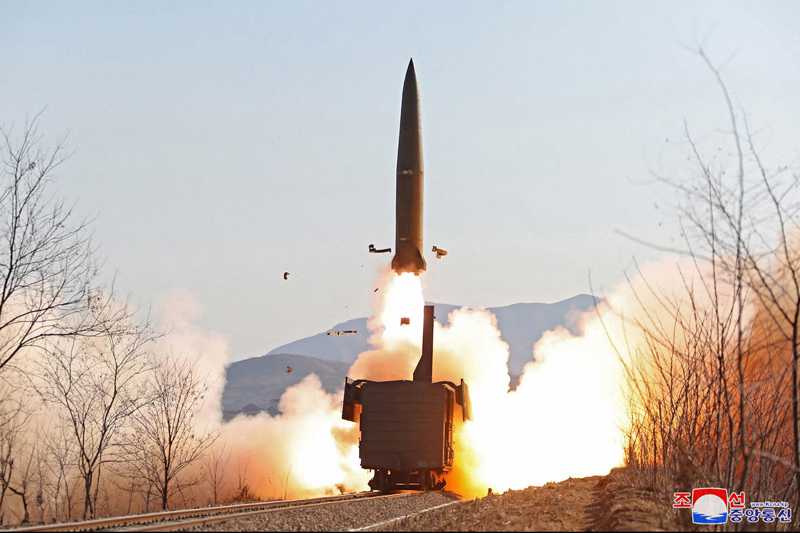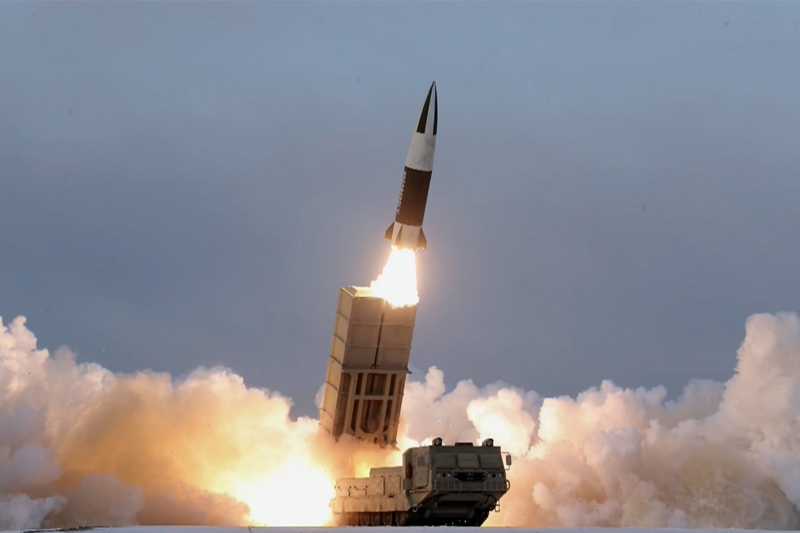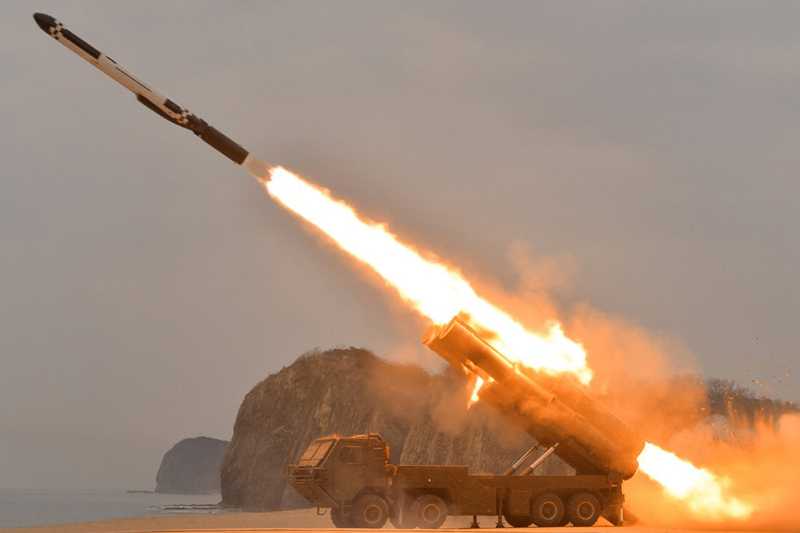North Korea conducts spectacular volley of missile tests
North Korea fired a pair of long-range land attack cruise missiles on 25 January. (KCNA)
Tensions between Russia and Ukraine, and China’s threatening actions against Taiwan, may have been grabbing international headlines, but North Korea recently reminded the world that it is far from a spent force.
It unleashed a volley of seven missile tests throughout January, culminating in an intermediate-range ballistic missile (IRBM) launch.
Pyongyang kicked off the latest set of tests with the launch of a ‘hypersonic missile’ that splashed down in the Sea of Japan on 5 January.
The country’s state-run Korean Central News Agency (KCNA) said after detaching from the rocket booster , the weapon’s ‘glide’ vehicle manoeuvred 120km laterally before hitting a target located 700km away ‘without any errors’.
The next test from a road-mobile launcher occurred on 11 January, also of the ‘hypersonic’ ballistic missile. It was launched from Jagang Province and landed in the Sea of Japan. Unlike the earlier one, this test was witnessed by supremo Kim Jong-un.
The missile flew more than 700km and up to 60km high, and the warhead reached a maximum speed of Mach 10 during its 240km turn. The KCNA said the test ‘was aimed at the final verification of overall technical specifications of the developed hypersonic weapon system.
It added that ‘the superior manoeuvrability of the hypersonic glide vehicle was more strikingly verified through the final test-fire’.

Pyongyang fired the first ‘hypersonic missile’ of the year on 5 January. It was followed by a second successful launch six days later. (KCNA)
However, it is more likely to have been a manoeuvring re-entry vehicle (MaRV) than a boost glide vehicle, as an MaRV is less manoeuvrable and not so demanding technically. However, North Korea did test a hypersonic boost glide vehicle with a Hwasong-8 missile in September 2021. Both these January tests appeared to use a shortened version of the Hwasong-12 IRBM.
Next up were two missiles fired by the railway missile regiment of the Korean People’s Army on 14 January. The KN-23 short-range ballistic missile (SRBM) launches from special railcars, 11 minutes apart, were designed to ‘check the proficiency’ of the regiment’s processes.
The KCNA added, ‘The drill was aimed at checking the alert posture of the combatants of the regiment and bolstering their ability of discharging firepower mission.’

Two KN-23 short-range ballistic missiles were fired by the railway missile regiment on 14 January. (KCNA)
Fired from North Pyongan Province, near the border with China, the KN-23s impacted 430km later in the Sea of Japan, after reaching an apogee of 36km. The first time North Korea tested these KN-23 SRBMs from railcars was on 15 September last year.
Following this was the launch of two more missiles four minutes apart from Sunan Airport in Pyongyang on 17 January. These KN-24 SRBMs were fired from tracked transporter-erector-launchers (TEL), and they hit North Korea’s favourite target, an island rock off the country’s eastern coast. This was a distance of 380km and the KM-24s achieved a maximum altitude of 42km.

Pyongyang launched two KN-24 SRNMs from Sunan Airport in Pyongyang on 17 January. (KCNA)
The state media agency explained: ‘The inspection firing test was conducted for the purpose of selectively inspecting the tactical guided missiles being produced and verifying the accuracy of the weapon system.’
These were followed on 25 January by two long-range land-attack cruise missiles (LACM) fired from inland.
The cruise missiles flew 26 minutes longer and more than 300km further than a test in September 2021. They flew for 2h 32 minutes, covering 1,800km. This confirms the North’s claim that these were ‘updated’ cruise missiles, presumably with a modified propulsion system.
Pyongyang could hit targets in South Korea and Japan with such LACMs, with launches from deep inside North Korea and evasive flight manoeuvres.

Two long-range land attack cruise missiles were fired on 25 January. The type had been shown at last October’s defence exhibition in Pyongyang. (KCNA)
Still not finished, North Korea then fired two more SRBMs from TELs in the vicinity of Hamhung on 27 January. They flew 190km with an apogee of 20km. This relatively low apogee would delay radar detection and reduce reaction time for missile defences, but at the expense of range.
This was the first launch of KN-23s with conventional warheads by road-mobile launchers since 2019, as more recent tests have been from railcars. It can be assumed that such KN-23 launchers are fully operational, and they are certainly nuclear-capable.

North Korea fired two KN-23 short-range ballistic missiles from TELs on 27 January. (KCNA)
On 12 January, the US had imposed sanctions against six North Koreans for obtaining missile technology. The leaders of Japan and US also held a virtual summit on 18 January, and they roundly condemned North Korea’s provocative missile launches.
A day earlier, Pyongyang made a thinly veiled threat that it would lift its moratorium on long-range missile tests that has been in place since 2017.
This significant escalation duly occurred on 30 January when North Korea fired a Hwasong-12 IRBM, its longest-range test since November 2017. The missile soared 1,200km high into space (that is far higher than the International Space Station’s 400km orbit) and finally impacted 800km out to sea.
This was obviously a lofted trajectory, but such measurements would give a maximum theoretical range of 4,300km for this IRBM, more than sufficient to reach Guam. It was fired from the same location as a Hwasong-14 ICBM on 28 July 2017.

This image released by the KCNA shows the Hwasong-12 IRBM test from 30 January. It includes pictures allegedly taken from outer space with a camera on the missile warhead. (KCNA)
In fact, this was the seventh launch of a Hwasong-12 IRBM, but the first since 2017 (three occurred in April 2017, and one each in May, August and September that year). Interestingly, the test did not make front-page news in domestic newspapers, and it was probably a user trial to make sure everything worked correctly.
With its moratorium broken, many analysts expect North Korea to fire an intercontinental ballistic missile (ICBM) in due course. With these theatrics, Kim will put the Korean Peninsula higher on President Joe Biden’s agenda, even as he deals with a possible Russian invasion of Ukraine, and figures out how to counter China.
Pyongyang last grabbed headlines with its missile tests in 2021, when it fired an intermediate-range cruise missile, railcar-mounted SRBM, hypersonic missile and air defence missile in September, and then a submarine-launched ballistic missile on 19 October 2021.
However, January’s 11 missile tests were even more numerous. In fact, in one month the country fired more missiles than it did in all of 2021.
February is unlikely to see anything so provocative, as Pyongyang shows respect for China as it hosts the Beijing Winter Olympics.
More from Defence Notes
-
![GAO calls for MDA to change cost estimates]()
GAO calls for MDA to change cost estimates
The US GAO has released a report pointing out that the MDA's cost estimates for systems that detect, track and defeat missiles are incomplete.
-
![What’s in a name? Poland revamps its procurement agencies]()
What’s in a name? Poland revamps its procurement agencies
The Polish MoD has introduced organisational reforms as it strives to make defence procurement processes smoother — but without broader political consensus, attempts at reform could fall flat.

























